Yet, the Pacific Northwest—particularly the state of Oregon—holds a unique and deeply paradoxical position in this historical landscape. While Oregon entered the Union as a free state in 1859, the state’s early legislation, settlement patterns, racial exclusions, and economic development were fundamentally entangled with the ideologies, economics, and legacies of slavery.
The prevailing myth of Oregon as a racially neutral or egalitarian frontier belies the institutional, legal, and social structures that actively enforced anti-Blackness, excluded African Americans, and benefited economically from systems of racial exploitation rooted in slavery and the broader slavery industrial complex of the United States.
To comprehend the magnitude of Oregon’s entanglement with American slavery, it is essential to interrogate the period of westward expansion and the ideological underpinnings of Manifest Destiny. Settlers who arrived in Oregon—particularly during the Great Migration of the 1840s—carried with them the racial prejudices and socio-economic hierarchies that were central to the antebellum South and Midwest. Many of these settlers were former slaveholders or pro-slavery sympathizers who envisioned Oregon not as a haven of liberty and inclusion but as a white utopia where the racial order of the East and South could be preserved without the presence of Black laborers or communities. Thus, even in the absence of a large enslaved population, Oregon's foundational legal codes and constitutional framework were undergirded by the economic logic and racial ideology of slavery.
The Oregon Territory, established in 1848, inherited a complex relationship with slavery from its settler population, many of whom hailed from slave states such as Missouri, Kentucky, and Tennessee. Although Congress had prohibited slavery in the territory through the provisions of the Northwest Ordinance and subsequent legislation, local settlers and territorial governments exhibited ambivalence and at times open defiance toward federal prohibitions. In 1843, the Provisional Government of Oregon passed a law banning slavery but simultaneously adopted a system of indentured servitude that functioned as a de facto institution of enslavement for African Americans brought into the region.
Enslaved individuals were coerced into labor under fixed terms, and settler-owners retained significant power over their lives and movements. The case of Robin Holmes, a formerly enslaved man who brought suit in 1853 to regain custody of his children from his enslaver, Nathaniel Ford, illustrates the persistent legal ambiguity and moral hypocrisy that characterized Oregon’s position on slavery. While Holmes ultimately succeeded in his legal challenge, the delay and resistance he encountered exemplified the state’s institutional commitment to white supremacy and its tacit tolerance for slavery-adjacent practices.
Oregon's 1857 state constitution, ratified two years before statehood, codified one of the most virulently racist legal frameworks in American history. Article I, Section 35, explicitly prohibited African Americans from residing, owning property, or making legal contracts within the state. These exclusion laws were not only expressions of social bigotry but also instruments of economic and political control designed to suppress the possibility of Black labor, autonomy, or social presence within Oregon’s boundaries. The paradox of a “free state” that simultaneously excluded Black people by law reveals a deep structural alignment with the broader racial capitalist system that undergirded American slavery. The state may have rejected the formal institution of chattel slavery, but it embraced the racial logics that defined and sustained it.
This dualism also manifested in Oregon’s economic development during the mid-nineteenth century. While the state lacked the plantation economy of the Deep South, it was nevertheless implicated in and benefited from the national slavery industrial complex. Oregon’s early agriculture, timber, and infrastructure sectors relied on capital, technologies, and markets made profitable by slavery in other regions.
Eastern investors who financed Oregon’s railroads, mining operations, and banks often derived their wealth from industries directly linked to slave labor, such as cotton production, sugar refining, and maritime commerce. Moreover, commodities like cotton, tobacco, and rice—produced by enslaved labor in the South—were integral to the expansion of Oregon’s shipping and mercantile economy through the ports of Portland and Astoria. Thus, Oregon’s economic modernization was not isolated from slavery but deeply dependent upon the capital flows, commodity chains, and financial networks shaped by human bondage.
Oregon’s institutions of higher learning were not exempt from this complicity. Willamette University, founded in 1842, and the University of Oregon, chartered in 1876, both operated within a broader intellectual milieu that upheld and perpetuated the tenets of white supremacy and racial exclusion. Many of their early benefactors, trustees, and faculty members were either apologists for slavery or participants in systems of racial exclusion.
The curricula, hiring practices, and student admissions policies of these institutions reflected and reinforced Oregon’s racialized social order. These colleges received endowments and land grants from individuals and institutions enriched by slavery, including Northern textile magnates who profited from Southern cotton. Thus, the intellectual development of Oregon—its production of knowledge, norms, and cultural identity—was shaped by and indebted to the labor of enslaved African Americans and the ideologies that dehumanized them.
Despite the state’s hostile legal and social environment, a small but resilient Black population emerged in Oregon, particularly in urban areas like Portland. These communities were often composed of formerly enslaved individuals, migrants from other states, or the descendants of Black pioneers who arrived in the Pacific Northwest despite the exclusion laws. Their presence defied the state’s official attempts to render Oregon a white-only domain. These Black Oregonians endured systemic disenfranchisement, housing segregation, economic marginalization, and physical violence, yet they established churches, mutual aid societies, and cultural institutions that formed the backbone of early Black civil society in the state. The Allen Temple CME Church, founded in Portland in 1865, is one of the earliest examples of Black institution-building in defiance of Oregon’s exclusionary regime.
The aftermath of the Civil War and the advent of Reconstruction brought limited but meaningful federal intervention in the form of the Freedmen’s Bureau. While the Bureau’s presence in Oregon was limited compared to the Southern states like Kansas, Kentucky, or Louisiana, its mission to support formerly enslaved people and facilitate their integration into civil society resonated with the efforts of Black communities in the Pacific Northwest.
The Bureau facilitated education, legal aid, and employment assistance, albeit in a context where local authorities and white citizens remained largely hostile to the idea of Black equality. The limited reach of the Freedmen’s Bureau in Oregon underscores the structural isolation of Black communities in the West and the broader national reluctance to challenge white supremacy outside the traditional confines of the former Confederacy.
Nevertheless, Black resistance in Oregon persisted through a lineage of abolitionists, educators, ministers, and civil rights laborers who laid the groundwork for future generations of activism. One such figure was Beatrice Morrow Cannady, a pioneering Black attorney, newspaper editor, and civil rights leader who fought tirelessly against the Ku Klux Klan and white supremacy in early twentieth-century Oregon. As editor of The Advocate, one of the few Black newspapers in the region, Cannady used her platform to challenge discriminatory laws, expose racist violence, and advocate for the civil and political rights of African Americans. Her efforts culminated in public campaigns to repeal Oregon’s exclusion laws, some of which remained on the books until the mid-twentieth century. Cannady’s legacy exemplifies the tradition of Black resistance in Oregon—a legacy forged in the face of profound legal, political, and cultural hostility.
The struggle for civil rights in Oregon continued throughout the twentieth century, shaped by national movements and localized expressions of Black activism. In the post-World War II era, the state experienced a demographic shift as African Americans migrated westward in search of economic opportunity and respite from Southern Jim Crow laws. Portland’s Albina District emerged as a center of Black life, culture, and resistance, even as it was targeted by redlining, urban renewal, and gentrification. Organizations such as the Portland NAACP and the Urban League of Portland played instrumental roles in advocating for housing equity, employment access, and desegregation. Activists like Otto Rutherford and Rev. Dr. John H. Jackson contributed to landmark legislative victories, including Oregon’s Public Accommodations Act of 1953, which prohibited racial discrimination in public spaces.
However, the structural legacies of slavery persisted in new forms. The exclusion laws of the nineteenth century gave way to zoning ordinances, policing practices, educational disparities, and systemic disinvestment in Black neighborhoods. These contemporary manifestations of anti-Blackness reveal the enduring imprint of slavery on Oregon’s political and economic landscape. The wealth gap between Black and white residents, the overrepresentation of African Americans in the criminal justice system, and the underrepresentation of Black students and faculty in Oregon’s universities are not merely contemporary social problems but historical continuities rooted in the state’s foundational commitment to racial exclusion.
Contemporary corporations and institutions in Oregon have begun to reckon with this history, albeit unevenly. Nike, headquartered in Beaverton, has faced scrutiny for its labor practices, diversity policies, and historical silence on racial justice. While not directly implicated in slavery, such corporations benefit from racial capitalism and labor exploitation systems descended from slavery’s economic logics. Similarly, Oregon’s universities have initiated studies and commemorations aimed at acknowledging their complicity in slavery and racial exclusion. These efforts—though important—must be understood as preliminary steps toward a more profound reckoning with the moral and material debts owed to the descendants of the enslaved.
In sum, the history of slavery in Oregon is not a narrative of absence but one of transformation and concealment. From exclusion laws and racial violence to economic entanglements and intellectual complicity, Oregon’s identity as a “free state” masks a deeper, more troubling legacy of racial subjugation. The slavery industrial complex extended its reach into the Pacific Northwest through economic dependency, settler ideology, legal frameworks, and institutional complicity. The resistance of Black Oregonians—from Robin Holmes to Beatrice Cannady—offers a counter-narrative of resilience and liberation that challenges the state’s whitewashed historical memory. To truly understand Oregon’s past and its present racial dynamics, one must confront the enduring shadows of slavery that continue to shape the contours of justice, equity, and historical truth in the Pacific Northwest.
The connection between slavery and Oregon’s socio-political architecture lies not only in legal and economic entanglements but also in the foundational settler-colonial logics that informed the development of the Oregon Territory. This region, carved from contested Indigenous lands, was envisioned by its Euro-American settlers as a racially exclusive project—a territory to be cleared, cultivated, and governed by and for white people. The Land Donation Act of 1850, the first federal homestead legislation in U.S. history, granted free land to white male settlers and their families. This legislation, while not explicitly tied to slavery in Oregon itself, was a direct analog to the Southern plantation model of land distribution and ownership. It structurally excluded not only African Americans, but also Indigenous peoples and Asian immigrants, reinforcing a racialized hierarchy of access to property, power, and personhood. The ideological parallels to the racial capitalism of the plantation South are unmistakable: land, labor, and legal status were organized along strict racial lines to ensure the economic and political dominance of white settlers.
The erasure of Oregon’s complicity in slavery and white supremacy has been maintained not only through legal structures and land policies, but also through historiographical omission. For decades, Oregon’s official historical narratives centered on the romanticized pioneer experience, valorizing figures such as John McLoughlin and Marcus Whitman while ignoring or minimizing the racial violence and exclusion that accompanied settlement. In school curricula, public monuments, and cultural commemorations, the voices of Black Oregonians—and the institution of slavery more broadly—were either silenced or framed as external to the region’s identity. This discursive erasure functioned to insulate Oregon from broader conversations about reparations, historical accountability, and structural racism. However, recent scholarly interventions and community-based historical recovery projects have begun to contest this sanitized narrative, unearthing the deeper roots of anti-Blackness and economic complicity in Oregon’s past.
One of the key areas in which Oregon’s connection to slavery manifested was in the migration and relocation of enslaved individuals to the region by white settlers. Despite formal legal prohibitions, settlers from Southern states regularly transported enslaved Black people to Oregon under the guise of indentures or extended “servant contracts.” These pseudo-legal arrangements were designed to evade anti-slavery statutes while retaining the exploitative power relations of chattel slavery. The story of James Saules, a Black sailor and musician who arrived in Oregon in the early 1840s, is illustrative of the complex position occupied by African Americans in the territory. Saules faced persistent surveillance, criminalization, and legal hostility, culminating in his being one of the individuals targeted by the 1844 exclusion law that threatened to whip any Black person who refused to leave the territory. Although this law was never fully enforced, its symbolic violence and underlying racial animus reflected a settler society deeply invested in Black exclusion and white purity.
Oregon’s racial exclusion laws—among the most extreme in the nation—functioned as de facto instruments of racial cleansing. The 1844 law, drafted by Peter Burnett (who would later become the first governor of California), mandated that all Black people vacate the territory under threat of violent punishment. While this law was later replaced by less overtly violent exclusions, the racial ideology persisted. The 1849 law, which remained in effect until 1854, prohibited any new Black residents from entering Oregon. The 1857 state constitution retained exclusionary provisions well after statehood, demonstrating that these were not temporary measures born of legal confusion but enduring principles of governance. Notably, these laws coexisted with a variety of economic practices that nonetheless relied upon the residual labor, cultural production, and consumption of Black Americans—especially through indirect means such as imported goods produced by enslaved people in other states. This hypocritical stance—desiring the fruits of slavery without the physical presence of its laborers—was emblematic of Oregon’s broader relationship to American slavery.
The labor market in early Oregon, though formally “free,” was deeply racialized and stratified. African Americans who managed to remain in the state despite exclusion laws were largely relegated to menial labor, domestic service, and low-paying industrial jobs. These labor positions were essential to the operation of the early Oregon economy, particularly in the growing urban centers of Portland, Salem, and Eugene. The state’s timber industry, railroad expansion, and port operations relied upon a cheap and often racially subordinated labor force. African Americans competed with Chinese immigrants and Indigenous people for the lowest rungs of employment, while white laborers often organized explicitly along racial lines to exclude nonwhite workers. Labor unions in Oregon, particularly in the early twentieth century, codified these exclusions, barring Black membership and reinforcing racial hierarchies that mirrored those of the antebellum South.
The state’s legal system likewise reinforced the logics of racial exclusion and labor exploitation. Black Oregonians faced discriminatory policing, legal disenfranchisement, and barriers to property ownership. Courts routinely sided with white plaintiffs and defendants in cases involving Black litigants, and the legal profession itself was overwhelmingly white, male, and exclusionary. This structural inequality was mirrored in the educational system. Black children were frequently denied access to public education or placed in underfunded, segregated schools. While Oregon did not have an extensive system of de jure segregation like the Jim Crow South, its de facto segregation was equally insidious and effective. These conditions created a feedback loop of poverty, marginalization, and systemic invisibility for the small but persistent Black population in the state.
Despite these immense challenges, Black Oregonians forged spaces of resistance, solidarity, and institution-building that defied the dominant structures of racial exclusion. The Black church was a central institution in this regard. In addition to the Allen Temple CME Church, other congregations such as the Vancouver Avenue First Baptist Church and the Mount Olivet Baptist Church emerged as vital centers of community life, political mobilization, and cultural preservation. These institutions functioned not only as religious spaces but as schools, political halls, and social service providers. They also provided critical networks for migration, employment, and civil rights organizing. The spiritual dimension of Black resistance in Oregon cannot be overstated; it served as both a theological affirmation of dignity in the face of white supremacy and a practical means of organizing against racial injustice.
Black intellectuals and journalists in Oregon also played a critical role in challenging the state’s racial regime. Beatrice Morrow Cannady’s publication, The Advocate, served as a crucial counter-public sphere where African Americans could articulate their grievances, circulate information, and mobilize support. The newspaper documented instances of racial discrimination, police violence, and legal injustice while also celebrating Black achievements and fostering a sense of communal pride. Cannady’s legal and journalistic efforts were complemented by her advocacy in education, where she fought for the inclusion of Black history and the hiring of Black teachers. Her activism represents a critical node in the long genealogy of Black civil rights labor in Oregon, linking the struggles of Reconstruction to the civil rights movements of the mid-twentieth century.
The rise of the Ku Klux Klan in Oregon during the 1920s marked a particularly violent phase in the state’s racial history. The Oregon chapter of the KKK was among the most powerful outside the South, with significant influence in state politics, law enforcement, and public education. The Klan’s platform extended beyond anti-Black racism to include anti-Catholicism, anti-Semitism, and xenophobia, but its racial animus was central to its appeal and operations. The Klan infiltrated school boards, police departments, and legislative bodies, further entrenching white supremacy in the state’s institutional fabric. Although the Klan’s formal power declined after the 1930s, its ideological legacy persisted in the form of segregated housing, discriminatory lending practices, and widespread racial prejudice.
The Albina District of Portland became the focal point of Black life in Oregon during the mid-twentieth century. This neighborhood, formed through racial redlining and forced segregation, was both a site of cultural flourishing and systemic neglect. Black-owned businesses, jazz clubs, barber shops, and social clubs proliferated in Albina, creating a vibrant cultural scene that resisted the state’s broader regime of exclusion. At the same time, Albina suffered from inadequate public services, underinvestment, and police harassment. In the 1960s and 70s, urban renewal projects, including the construction of the Memorial Coliseum and Interstate 5, decimated much of the neighborhood, displacing hundreds of Black families and erasing critical sites of historical memory. These projects were often justified in the language of progress and modernization but were in fact mechanisms of racial dispossession and erasure.
The displacement of Black communities through urban renewal paralleled broader national trends in the postwar period, but in Oregon it had particularly devastating consequences due to the already small size and limited mobility of the Black population. The loss of Albina as a cultural and residential hub exacerbated economic inequality and fragmented the communal networks that had sustained Black life in the state. The result was a spatial and social marginalization that rendered Black Oregonians increasingly invisible in public life and policymaking. This structural invisibility was compounded by a resurgence of racial animus in the 1980s and 1990s, when neo-Nazi and white supremacist groups gained traction in Oregon, culminating in high-profile incidents of racial violence and hate crimes.
Yet, resistance continued. Organizations such as the Black United Front, the Coalition of Black Men, and the Urban League of Portland fought to preserve Black culture, demand accountability, and create opportunities for youth and community development. Legal advocates and scholars began to document the persistent legacies of exclusion and advocate for reparative policies. Public historians and community archivists undertook the laborious task of recovering suppressed histories, building archives, and creating educational materials that told the full story of Black Oregon. These efforts have culminated in a renewed focus on truth-telling, historical justice, and structural change.
In the twenty-first century, the legacies of slavery in Oregon are manifest in multiple domains: in the racial wealth gap, in the disproportionate policing and incarceration of Black residents, in educational disparities, and in the persistent underrepresentation of African Americans in political and institutional leadership. Universities in Oregon have begun to confront their own complicity, with institutions such as Portland State University, Oregon State University, and the University of Oregon launching diversity and inclusion initiatives, conducting historical audits, and creating racial justice task forces. Yet, these efforts often remain superficial or symbolic, lacking the material investments and policy changes required to address centuries of dispossession and exclusion.
Corporations headquartered in Oregon have also been implicated in these discussions. Nike, Intel, and other major companies have made public commitments to racial equity, yet their hiring practices, executive leadership demographics, and community investment strategies often fail to meet the needs of the Black population. Corporate social responsibility initiatives that ignore the historical roots of racial inequality risk reproducing the same dynamics they purport to challenge. To be truly transformative, such initiatives must reckon with the economic histories that made these corporations possible—including the indirect benefits derived from slavery and racial capitalism.
The question of reparations has gained increasing traction in Oregon, with advocates calling for targeted investments in Black education, housing, healthcare, and cultural preservation. These demands are rooted not in abstract notions of fairness but in empirical analyses of historical harm. Reparations in Oregon would necessarily involve land redistribution, financial restitution, and the establishment of institutions controlled by Black communities to meet their own needs. This would require a fundamental restructuring of the state’s legal, economic, and political order—a transformation commensurate with the depth of the injury inflicted over generations.
At the heart of this discourse is a moral imperative: to recognize that the condition of Black Oregonians today is not the result of individual failings or isolated incidents, but the product of a systemic project that stretches back to the foundations of the state itself. From the exclusion laws of the 1840s to the redlining of the 1950s, from the cultural erasure of the 1970s to the mass incarceration of the 1990s, Oregon has consistently enacted policies that marginalized, criminalized, and dispossessed its Black residents. The legacy of slavery in Oregon is thus not merely a historical footnote but a living structure—a scaffolding of inequality that must be dismantled with the same intentionality and violence with which it was built.
The future of Oregon hinges upon its ability to confront this legacy with honesty, courage, and a willingness to undertake structural change. This requires not only policy reform but cultural transformation. It requires the elevation of Black voices, the redistribution of power, and the recognition that true freedom cannot exist without justice. In acknowledging its historical entanglement with slavery, Oregon has an opportunity to chart a new path—one rooted not in exclusion and denial, but in memory, accountability, and liberation.
As the twenty-first century unfolds, Oregon finds itself at an inflection point—a moment in which historical reckoning, public discourse, and structural inequality collide. The legacy of slavery, though never codified in Oregon with the same systemic intensity as in the Southern states, nevertheless persists as a latent but formidable presence. It reverberates not only through the racialized outcomes in education, healthcare, housing, and law enforcement but also through the cultural psyche of a state that has long cultivated the myth of racial innocence. Disentangling that myth and reconstructing an honest narrative requires a painstaking and often uncomfortable excavation of Oregon’s legal, economic, and institutional complicity in slavery and its afterlife.
The process of historical redress must begin with a deeper interrogation of Oregon’s foundational texts, particularly the state constitution. Ratified in 1857, Oregon’s constitution contained not only provisions excluding African Americans from legal and civil participation but also clauses that reflected broader national anxieties about the limits of white liberty and Black freedom. These laws were not merely rhetorical; they had material consequences.
Black exclusion in Oregon was enforced by deputized white citizens, who were empowered to harass, report, or physically remove African Americans who attempted to settle in the state. Local law enforcement officers often served as the instruments of this racial expulsion. The logic behind these legal practices was not solely about racial prejudice in a cultural sense, but about protecting the economic and political primacy of white settlers. By excluding Black laborers and communities, Oregon’s ruling class sought to monopolize access to land, employment, and the benefits of statehood.
These dynamics became even more complex in the years following the Civil War. As Oregon transitioned from a frontier territory to an integrated member of the Union, it participated in the national debate over Reconstruction. However, Oregon’s political leadership largely opposed the principles of Reconstruction, particularly the extension of civil rights and voting protections to African Americans. Oregon was one of the few Union states to initially reject the Fourteenth and Fifteenth Amendments, which respectively guaranteed citizenship and voting rights to formerly enslaved people. This resistance was not coincidental but indicative of a broader political consensus rooted in white supremacist ideology. Oregon may have been geographically removed from the South, but ideologically it shared many of the same principles of racial hierarchy, legal exclusion, and economic monopolization.
The Freedmen’s Bureau, though it had minimal formal presence in Oregon, functioned as a symbolic referent for the broader national conversation about racial justice and economic reparations. The Bureau’s mission—to provide legal support, education, housing, and employment to freed people—was antithetical to the prevailing political ethos in Oregon. Local newspapers decried federal efforts to promote racial equity, warning of the “dangers” of social equality and the dilution of white civic identity. Even in the absence of large Black populations, the specter of federal intervention was used to galvanize white voters against racial progress. These sentiments were reinforced through education, religion, and media, creating a cultural environment in which Black exclusion was not only legal but morally justified in the eyes of many Oregonians.
This ideological infrastructure extended into higher education, where the construction of knowledge itself was complicit in the erasure of Black experiences and the validation of white supremacy. Universities such as the University of Oregon, Oregon State University, and Willamette University, though established as institutions of public learning and intellectual growth, frequently excluded African Americans from enrollment, faculty appointments, and leadership roles well into the twentieth century. Moreover, the intellectual canon taught in these institutions mirrored national academic trends that either ignored the history of slavery or framed it as a benign or necessary institution. Courses in history, economics, literature, and political science often failed to address the centrality of slavery to the American project, thus reinforcing a sanitized narrative that allowed students to emerge with little understanding of the country’s racial foundations.
When African Americans did begin to enroll in these universities, they faced pervasive discrimination. Housing policies often relegated Black students to inferior or off-campus accommodations. Classroom environments were frequently hostile or alienating, with few faculty of color and little curricular representation of Black thought or experience. Nevertheless, Black students and scholars persisted, forming organizations such as the Black Student Union and African American student councils that demanded representation, curriculum reform, and institutional accountability. Their activism laid the groundwork for more recent efforts to decolonize the university and introduce racial justice frameworks into academia.
The economic dimensions of Oregon’s complicity in slavery’s legacy are equally profound. While Oregon never had a plantation economy, its industries were nonetheless interwoven with the broader networks of capital accumulation made possible by slave labor. Timber, agriculture, fishing, and shipping—all foundational to Oregon’s economic development—benefited from markets and supply chains tied to slavery. Cotton and sugar from the South were shipped through Oregon’s ports; profits from those trades financed banks and insurance companies that underwrote Oregon enterprises. Railroads, which connected the state to national and international markets, were funded in part by investors who had profited from slave labor. The early fortunes that built Portland’s financial and real estate empires were frequently derived from investments in or trade with regions where slavery was essential.
As these wealth accumulations translated into institutional power, the beneficiaries often endowed philanthropic funds, university chairs, and public infrastructure that still bear their names today. Yet, the sources of their wealth remain unacknowledged in most public commemorations. This elision is not accidental—it represents a broader societal refusal to confront the reality that Oregon’s prosperity was partially underwritten by the suffering of enslaved people thousands of miles away. To engage in authentic historical justice, it is imperative that Oregon re-examines the economic genealogy of its institutions, names the beneficiaries of slavery-derived wealth, and considers how that wealth might be redistributed to address historical harm.
In the twentieth and twenty-first centuries, these historical patterns have metastasized into contemporary systems of racial control and dispossession. Mass incarceration in Oregon reflects national trends in the criminalization of Black bodies, with African Americans incarcerated at disproportionate rates relative to their population size.
These disparities are not the result of elevated crime rates, as is often claimed, but of targeted policing, prosecutorial discretion, and judicial bias. Black neighborhoods, particularly in Portland, have been subject to intensive surveillance and militarized policing tactics, often under the guise of public safety. The carceral system functions as a continuation of slavery by other means—a means of extracting labor, suppressing political participation, and maintaining economic stratification.
Policing in Oregon cannot be understood apart from the historical context of Black exclusion. Law enforcement agencies were originally tasked with enforcing the exclusion laws and maintaining the racial purity of white settlements. As those laws were repealed, the function of law enforcement shifted toward the management of racialized populations through surveillance, discipline, and incarceration. This dynamic is evident in the over-policing of Black youth, the use of gang databases, and the targeting of Black motorists under the pretext of traffic stops. These practices, while legally sanctioned, are deeply rooted in a historical continuum that links the antebellum slave patrol to the modern police officer.
Housing policy represents another domain in which the legacy of slavery exerts a powerful influence. Redlining, restrictive covenants, and discriminatory lending practices systematically excluded African Americans from homeownership in Oregon for much of the twentieth century. The federal Home Owners’ Loan Corporation (HOLC), in collaboration with local banks and real estate agencies, designated Black neighborhoods as high-risk, thereby denying them access to mortgage financing. As a result, Black families were relegated to overcrowded, poorly maintained rental properties, often in industrial or flood-prone areas. These patterns not only limited intergenerational wealth accumulation but also reinforced spatial segregation that persists to this day.
Even after the formal end of redlining, the legacy of these policies remained embedded in zoning laws, property valuation formulas, and urban development plans. Gentrification in cities like Portland has accelerated the displacement of Black communities under the guise of revitalization and economic growth. Public transportation projects, bike lanes, and boutique real estate developments have replaced historically Black neighborhoods, displacing long-time residents who can no longer afford to live in the areas they once built and maintained. The erasure of these communities is not merely physical—it is cultural, psychological, and intergenerational.
Education is yet another arena where the legacy of slavery manifests in Oregon. Public schools in predominantly Black neighborhoods are often underfunded, over-policed, and deprived of culturally relevant curricula. Black students face higher rates of suspension and expulsion, are disproportionately placed in remedial or special education programs, and are frequently discouraged from pursuing advanced coursework. These disparities are not incidental but reflect a broader system of educational apartheid that traces its lineage to the era when enslaved people were legally forbidden from learning to read or write.
The curriculum itself often omits or distorts the history of slavery, framing it as a Southern aberration rather than a national institution. Oregon’s own exclusionary history is frequently glossed over in textbooks, leaving students with an incomplete or misleading understanding of the state’s racial past. This curricular amnesia serves to protect white innocence at the expense of historical truth and to reproduce the conditions that make racial inequality appear natural or inevitable. Efforts to reform the curriculum, introduce ethnic studies, and train culturally competent educators are vital steps, but they must be accompanied by structural investments in Black education and leadership.
Cultural institutions also bear responsibility for the perpetuation or contestation of slavery’s legacy. Museums, libraries, and public monuments in Oregon have historically centered white settler narratives while marginalizing or erasing Black experiences. However, recent initiatives such as the Oregon Black Pioneers exhibit, the Vanport Mosaic, and the Albina Vision Trust have sought to reclaim and elevate Black history within the state. These projects not only recover lost narratives but challenge dominant historiographies that equate Oregon’s identity with whiteness. They also serve as platforms for intergenerational dialogue, public education, and policy advocacy.
The movement for reparations in Oregon, though still nascent, draws upon these historical and contemporary injustices to articulate a comprehensive vision of repair. Reparations in this context are not limited to financial compensation but include land return, institutional accountability, community investment, and cultural affirmation. They seek to redress not only the material losses incurred by Black Oregonians but also the spiritual, psychological, and epistemic harms inflicted by centuries of exclusion, exploitation, and erasure. A reparative framework demands that Oregon reckon with its past not as an abstract moral failing but as an ongoing structure of dispossession that requires dismantling.
The vision of a post-reparations Oregon is one in which Black communities are no longer marginal but central to the state’s political, economic, and cultural life. It is a vision in which institutions of higher learning acknowledge their histories, implement inclusive hiring and admissions policies, and support research that advances racial justice. It is a vision in which housing is not a site of racial wealth extraction but of stability and dignity. It is a vision in which policing is transformed into a system of community accountability, and incarceration is replaced by restorative models of justice. And it is a vision in which every child in Oregon learns not only about the state’s exclusion laws but about the Black leaders, laborers, thinkers, and freedom fighters who resisted them.
To move toward this vision, Oregon must commit to an ethos of historical accountability that transcends symbolic gestures. Plaques, apologies, and commemorative days are not sufficient. What is required is a structural realignment of values, resources, and power. This realignment must be informed by the voices of those who have been historically excluded—those whose ancestors were enslaved, displaced, and dehumanized in the service of a racial order that still endures. Only by centering these voices can Oregon begin to build a future that is not haunted by its past but transformed by its reckoning with it.
The continued evolution of Oregon’s legacy of slavery is embedded in the ways historical amnesia coexists with enduring inequality. As the state transitioned into the modern era, its foundational anti-Black laws and racialized exclusions did not simply dissipate; they metamorphosed into structural barriers manifest in real estate redlining, employment discrimination, environmental injustice, and gentrification. In Portland and other urban centers, African Americans who had carved out neighborhoods during the Great Migration and postwar industrial boom found themselves displaced by freeway construction, urban renewal, and aggressive property development. These trends were not incidental or benign; they followed the logic of dispossession that originated with enslavement and land expropriation in the 19th century. The geography of anti-Blackness in Oregon may have altered in form, but it retained the DNA of the slave economy—an economy that, although minimal in its literal manifestation in Oregon, held maximum symbolic and structural force.
The very architecture of civic space, public institutions, and commercial enterprise in Oregon tells the story of layered racial exclusion. Universities such as the University of Oregon, Oregon State University, and Portland State University have all benefited, directly or indirectly, from the system of slavery and the white supremacist ideologies that justified it. These institutions were built on land that had been expropriated through settler colonial conquest, often enriched by capital generated through exploitative labor systems.
Many of the early donors, trustees, or faculty were proponents of exclusionary policies, and the intellectual foundations of racial pseudoscience were disseminated through their curricula, thus reproducing the racial hierarchies that had enabled slavery. The archival traces of these entanglements are not speculative; they are found in the minutes of governing boards, property records, endowment portfolios, and public policy decisions. Yet until recently, these institutions offered little acknowledgment, and even less redress, of their complicity in maintaining the epistemic and material violence of the slavery complex.
Corporate complicity in Oregon’s legacy of slavery has also gone largely unexamined. Timber companies, railroad enterprises, agricultural conglomerates, and insurance firms operating in the state have roots in financial networks that directly profited from the American slave trade. Life insurance companies that underwrote enslaved people as property extended their services into the Pacific Northwest, where they facilitated settler economic expansion and cemented the racialized hierarchies of credit and capital access.
Banks with origins in the antebellum era expanded into Oregon markets with capital reserves partially derived from slave-backed assets. Even multinational companies with headquarters or major operations in Oregon—such as Nike and Intel—operate within a state where the wealth gap between Black and white Oregonians cannot be understood apart from the historic legacies of slavery, racial exclusion, and structural denial of intergenerational wealth-building opportunities.
The echoes of slavery also persist in the criminal justice system, which disproportionately targets Black Oregonians for surveillance, incarceration, and police violence. These contemporary realities bear the genealogical stamp of Black Codes, vagrancy laws, and the carceral logics developed in the post-emancipation South but translated across geographies. Oregon’s own penal system expanded alongside the national turn toward mass incarceration in the latter half of the 20th century, using racialized crime panics to justify punitive policies that effectively re-enslaved Black populations through prison labor and civic exclusion. The language may have shifted—from “slave” to “felon,” from “plantation” to “prison-industrial complex”—but the underlying rationale remained eerily familiar: racial containment in service of white economic and political supremacy.
Despite the gravitational pull of this historical weight, Black Oregonians have never been merely the passive subjects of oppression. They have consistently challenged, resisted, and reimagined the social order. The spirit of resistance exemplified by early abolitionists, Civil Rights pioneers, and contemporary activists reveals an enduring countercurrent to the state’s hegemonic racial ideologies. Figures such as Beatrice Morrow Cannady not only fought for civil liberties in the courts and press but also crafted a counternarrative of dignity, resilience, and Black futurity. Community leaders in the Albina neighborhood organized against redlining and displacement, creating mutual aid networks, cultural centers, and political organizations that advanced Black autonomy and survival. Youth activists today, often drawing inspiration from historical struggles, demand racial justice through climate activism, prison abolition, educational equity, and economic reparation.
Their work underscores the necessity of memory as a political act. Public memory in Oregon has long suffered from erasure and distortion when it comes to slavery and Black life. Historical markers, public monuments, school curricula, and civic commemorations have overwhelmingly centered white pioneer narratives while marginalizing or outright omitting the lived experiences and contributions of Black residents. This distortion is itself a form of epistemic violence—one that compounds the material legacies of slavery by denying Black communities narrative agency. However, the emergence of historical justice movements, public humanities projects, and grassroots Black history initiatives has begun to contest this sanitized memoryscape. By reclaiming archival materials, oral histories, and cultural landscapes, these projects unsettle Oregon’s myths of innocence and frontier exceptionalism, insisting instead on a more honest and inclusive accounting.
The legal and legislative dimensions of this reckoning have also begun to shift. Land acknowledgments, while sometimes tokenistic, reflect an opening to conversations about structural dispossession. Legislative resolutions recognizing Juneteenth and other Black commemorative practices provide symbolic affirmation of past injustices. Reparations debates—once confined to the political margins—are increasingly part of public discourse, even if substantive restitution remains elusive. The state’s commission on racial equity and historical injustice offers one avenue, however bureaucratic, through which the legacies of slavery might be addressed at the policy level. Yet such efforts will require more than performative recognition; they demand redistributive justice grounded in historical truth.
To move toward that truth, one must grapple with the moral implications of Oregon’s participation in the system of slavery, however oblique or disavowed. The notion that Oregon was somehow peripheral to the slave economy is not merely incorrect—it is a form of ideological cover that prevents meaningful engagement with the structures that continue to produce racial disparity. The illusion of Oregon’s distance from slavery relies on a narrow definition of enslavement as a Southern and bygone phenomenon, rather than as a national system with global implications and temporal reach. Slavery was not only a labor system; it was a worldview, a mode of property, a theory of personhood, and a legal infrastructure. All of these elements shaped Oregon’s development, from its exclusionary laws to its economic stratification, from its educational institutions to its cultural identities.
The challenge, then, is not simply to excavate historical facts but to integrate them into the ethical fabric of public life. A society that fails to reckon with its past is condemned to reproduce it in new forms. In Oregon, reckoning means acknowledging that slavery, though officially outlawed, left sedimented layers of anti-Black violence that have not yet been dismantled. It means recognizing that freedom, as articulated in the abolitionist tradition, was never simply the absence of chains but the presence of justice, equality, and human flourishing. It means interrogating how institutions—academic, economic, judicial, and cultural—continue to benefit from the racialized foundations laid during slavery’s reign. And it means listening to the descendants of the enslaved, whose lived realities offer both testimony to injustice and blueprints for liberation.
In closing, Oregon’s story is not unique in its complicity with slavery, but it is singular in how it sought to construct a white utopia under the banner of “freedom.” That contradiction—freedom predicated on exclusion—resonates still in the social, economic, and political configurations of the state. The work of confronting this legacy cannot be outsourced to historians or activists alone. It must become a collective endeavor rooted in humility, accountability, and moral clarity. Only then can Oregon begin to repair the deep fissures wrought by a system of human commodification that, while abolished in law, persists in form. Slavery’s afterlives remain inscribed in the land, the law, and the ledger. To challenge them is to commit to a future that breaks, rather than extends, their grip on the present.
The collective legacy of slavery in Oregon, though often underacknowledged in both national and regional narratives, continues to shape the sociopolitical and economic dimensions of the state well into the twenty-first century. Despite Oregon's early attempts to craft an identity distinct from the explicit pro-slavery ideologies of the American South, the state's trajectory was intricately enmeshed in anti-Black legislation, racial exclusion, and economic systems that profited from the institution of slavery. These dimensions were not only constructed through overt policies but were reinforced through systemic omissions, academic silence, and cultural amnesia that served to protect hegemonic structures and preserve white ascendancy in the Pacific Northwest.
A central feature of Oregon’s racial legacy lies in the state's foundational legal apparatus, one that codified anti-Blackness into its constitutional DNA. The Oregon Constitution of 1857, which specifically excluded Black people from settling, working, or owning property in the state, was a radical assertion of settler colonialism and racial hierarchy. While other Northern states allowed Black residents in varying degrees, Oregon uniquely embedded exclusion as a legal and cultural norm. Even as slavery was technically banned by Oregon's statehood, the exclusionary policies operated as a functional equivalent of enslavement, denying African Americans not just liberty, but the very possibility of belonging.
These legislative architectures operated in tandem with economic developments that mirrored the broader national slavery industrial complex. As previously illuminated, Oregon's participation in national and global markets—particularly through agriculture, lumber, railroad expansion, and university endowments—linked it materially to enslaved labor in other states. The profits generated from Southern slavery were laundered through investments into Oregonian institutions, including land purchases, industrial operations, and philanthropic gifts that helped shape the University of Oregon, Willamette University, and other cultural landmarks. Although Oregon lacked large plantations or urban slave markets, it certainly did not lack complicity or benefit.
The role of financial and corporate institutions in the state further reveals a hidden genealogy of capital derived from the slave economy. Insurance companies underwriting slave lives, banks processing Southern cotton accounts, and railroads that depended on enslaved or racially subjugated labor all embedded the state into a nationwide lattice of exploitative wealth production. That wealth, once transferred or reinvested in the form of real estate or university endowments, effectively disassociated itself from its violent origins. This laundering of slave capital into clean institutional frameworks perpetuated historical amnesia and allowed these organizations to thrive while their Black counterparts were legally barred from ownership, employment, and community participation.
Simultaneously, migration patterns into and out of Oregon represented another vector of this racialized regime. African Americans who attempted to settle in Oregon were often met with expulsion, imprisonment, or economic sabotage. Others were enticed by false promises of inclusion during post-Civil War reconstruction, only to encounter de facto segregation and white supremacist intimidation upon arrival. Those who stayed carved out enclaves of resistance, including small but determined communities in Portland, Eugene, and Salem. These populations, though systematically undermined, nurtured legacies of resilience, culture, and activism that continue to define Black Oregonian identity today.
Into the twentieth century, the same white settler logics that structured the state's founding mutated into new forms of exclusion. Redlining, racially restrictive covenants, educational segregation, and employment discrimination became the normative methods of ensuring white dominance in urban and rural spaces alike. The Federal Housing Administration and local realtors systemically denied Black families the right to purchase homes in desirable areas, leading to entrenched patterns of spatial apartheid in cities like Portland. These racialized housing policies were not incidental but rather purposeful tools designed to marginalize and disenfranchise, reflecting the continuity of anti-Black exclusion rooted in Oregon’s antebellum period.
In response, Black civil rights laborers and freedom fighters in Oregon waged a multifaceted struggle for equity and justice. Leaders such as Beatrice Morrow Cannady, the first Black woman to graduate from Northwestern College of Law, mobilized legal challenges, published newsletters, and organized against Ku Klux Klan activities in the 1920s. She challenged Oregon's exclusion laws in court and fought tirelessly for civil rights legislation. Similarly, Reverend Allen Bethel and the Albina Ministerial Alliance in the late twentieth century led grassroots efforts to address police brutality, employment discrimination, and educational inequality. These movements, while often overlooked in mainstream accounts, represent critical threads in Oregon’s historical tapestry, demonstrating the unbroken lineage of Black resistance and visionary leadership.
The Black Panther Party’s Portland chapter, founded in 1969, was another iteration of this enduring resistance, arising in direct response to police violence, unemployment, and poor housing conditions in Black neighborhoods. The Party established community health clinics, conducted political education, and fought for systemic reform. This activism catalyzed a broader awareness of racial injustice in Oregon and marked a turning point in how the state reckoned with its own racial contradictions. While met with state surveillance and institutional repression, these activists continued a tradition of radical reimagining that pushed against the boundaries of Oregon’s foundational exclusions.
Parallel to these efforts were cultural and academic interventions designed to reclaim and re-narrate Oregon’s racial history. Scholars such as Darrell Millner, Walidah Imarisha, and Carmen P. Thompson have offered critical frameworks for understanding Oregon’s anti-Black past through both scholarly research and public education. These intellectuals dismantle the myth of Oregon as a liberal utopia and instead illuminate the deep-rooted structures of white supremacy that undergird the state’s social and political institutions. Their work represents not merely academic inquiry but a form of reparative justice that seeks to tell the truth about Oregon’s past.
Within this context, Oregon’s participation in the Freedmen’s Bureau efforts—while minimal compared to states further south—must be considered symbolically and operationally. Though Oregon did not host large-scale Bureau operations, the ideas and policies developed by the Bureau were mirrored in Oregon’s occasional gestures toward Black inclusion during Reconstruction. These efforts, however, were limited by the continued dominance of white nativist and settler-colonial ideologies that sought to preserve Oregon as a white sanctuary. Even post-emancipation support structures were weaponized to deny full civic inclusion to Black Oregonians, showing how even federal policies of liberation could be selectively deployed or obstructed.
Ultimately, the contradictions embedded in Oregon’s racial history reflect a broader American tension between liberal ideals and racialized practices. Oregon simultaneously imagined itself as a land of freedom and opportunity while embedding racial exclusion into law and custom. It embraced federal unionism while resisting the implications of Black emancipation. It championed public education while denying Black students equal access. These contradictions are not anomalies but rather constitutive features of the state's racial architecture.
To confront this history meaningfully requires more than acknowledgment—it demands reparative action. Institutions that benefited from slave wealth and exclusionary policies must reckon with their past through restorative justice frameworks. This includes financial reparations, curricular reform, public memorialization, and sustained investment in Black communities. Moreover, the state itself must address its historical complicity through policy change, education reform, and the amplification of Black voices in public discourse.
The work of dismantling the afterlives of slavery in Oregon is ongoing. It is a labor of remembrance, justice, and structural transformation. From the exclusion laws of the 1850s to the gentrification policies of the twenty-first century, the legacy of slavery remains inscribed in the legal, economic, and spatial geographies of the state. Only through sustained commitment to historical truth and racial equity can Oregon begin to repair the profound damage inflicted by centuries of anti-Black violence and erasure.
Thus, Oregon’s legacy of slavery—however obscured by regional mythologies of freedom—persists as a haunting yet clarifying force. It demands not only historical excavation but also political courage and ethical reckoning. The names, stories, and labors of those who resisted—enslaved, emancipated, and descendant—call for a reconstitution of the public conscience and a reinvestment in the very ideals that slavery betrayed. That reckoning must begin now, with truth at its center and justice as its compass.
Oregon Flashpoint
Blacks likely began arriving in Oregon in the 1500s as free and enslaved passengers of English and Spanish ships. The first confirmed presence of a person of African descent in Oregon is Marcus Lopius, a crew member from Cabo Verde aboard the American ship Lady Washington that reached Oregon in 1788. An enslaved man known as York came to Oregon in 1803 as part of the Lewis and Clark Expedition. Other early Black explorers came overland to Oregon as free trappers or as laborers for John Jacob Astor's Pacific Fur Company and the British Hudson Bay Company.Both enslaved and free Black people settled in Oregon in the 1840s and 50s. Although slavery had been outlawed in Oregon since the 1843 Organic Laws of Oregon, at least 40 enslaved Black people were brought to the Oregon Country. Some remained enslaved for years after their arrival.
In 1844, George Washington Bush traveled west on the Oregon Trail. After hearing about Oregon's exclusion law he decided not to settle in the Oregon Territory, and settled in what would become Washington Territory instead. According to Perseverance, “By 1860, African Americans were present in fourteen of the nineteen Oregon counties.”
The Oregon black exclusion laws were attempts to prevent black people from settling within the borders of the settlement and eventual U.S. state of Oregon. The first such law took effect in 1844, when the Provisional Government of Oregon voted to exclude black settlers from Oregon's borders. The law authorized a punishment for any black settler remaining in the territory to be whipped with "not less than twenty nor more than thirty-nine stripes" for every six months they remained. Additional laws aimed at African Americans entering Oregon were ratified in 1849 and 1857. The last of these laws was repealed in 1926. The laws, born of anti-slavery and anti-black beliefs, were often justified as a reaction to fears of black people instigating Native American uprisings.

















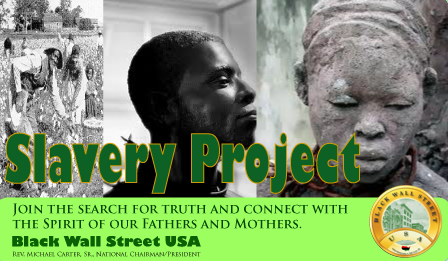
Alabama
Alaska
Arizona
Arkansas
California
Colorado
Connecticut
Delaware
Florida
Georgia
Hawaii
Idaho
Illinois
Indiana
Iowa
Kansas
Kentucky
Louisiana
Maine
Maryland
Massachusetts
Michigan
Minnesota
Mississippi
Missouri
Montana
Nebraska
Nevada
New Hampshire
New Jersey
New Mexico
New York
North Carolina
North Dakota
Ohio
Oklahoma
Oregon
Pennsylvania
Rhode Island
South Carolina
South Dakota
Tennessee
Texas
Utah
Vermont
Virginia
Washington
Washington D.C.
West Virginia
Wisconsin
Wyoming

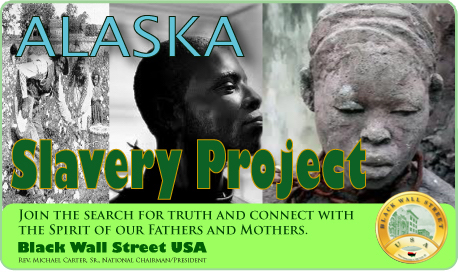
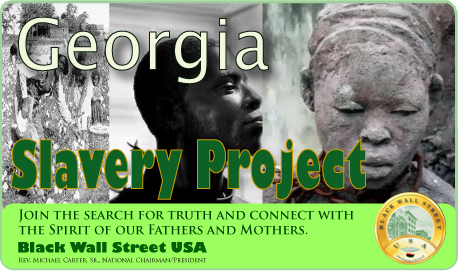

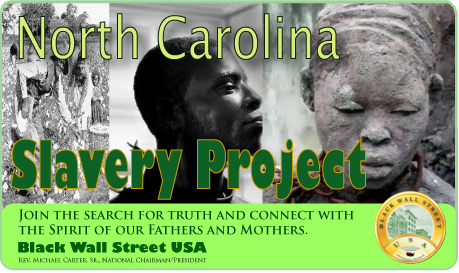
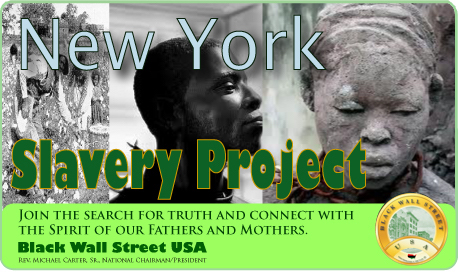

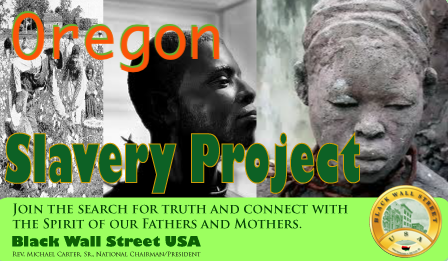

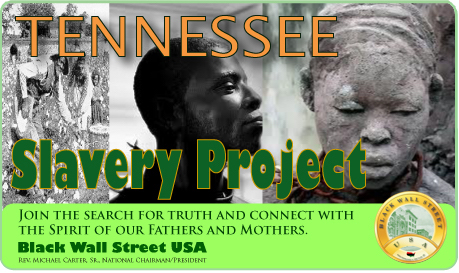
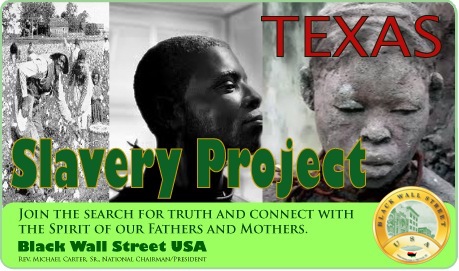
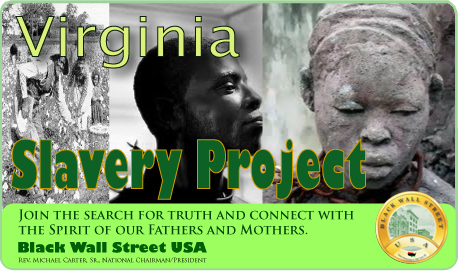


BlackWallStreet.org

Slave Records By State
See: Slave Records By State
Freedmen's Bureau Records
See: Freedmen's Bureau Online
American Slavery Records
See: American Slavery Records
American Slavery: Slave Narratives
See: Slave Narratives
American Slavery: Slave Owners
See: Slave Owners
American Slavery: Slave Records By County
See: Slave Records By County
American Slavery: Underground Railroad
See: American Slavery: Underground Railroad

